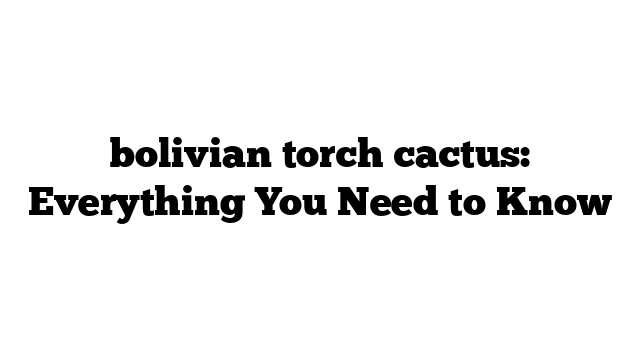Introduction:
The Bolivian torch cactus, scientifically known as Trichocereus bridgesii, is a unique and fascinating plant native to Bolivia. It belongs to the Cactaceae family and is often sought after by cactus enthusiasts for its striking appearance and psychoactive properties. In this article, we will delve into everything you need to know about the Bolivian torch cactus, from its natural habitat and physical characteristics to its cultivation, care, and uses.
Natural Habitat:
The Bolivian torch cactus is typically found growing in the high deserts of Bolivia, specifically the regions of La Paz and Cochabamba. It thrives in altitudes ranging from 2,000 to 3,000 meters above sea level, where it experiences a semi-arid climate characterized by cool temperatures, moderate rainfall, and low humidity. The cactus is often found growing on rocky slopes and hillsides, where it can take advantage of the well-drained soil and ample sunlight.
Physical Characteristics:
The Bolivian torch cactus is a columnar cactus that can grow up to 6 meters tall in its natural habitat. However, when cultivated outdoors or in containers, it typically reaches a height of around 2 to 3 meters. The cactus has a cylindrical or slightly ribbed stem, which can vary in color from light green to bluish-green. The stem is covered in prominent, sharp spines that can range in color from yellow to brown.
One of the most striking features of the Bolivian torch cactus is its areoles, which are small, woolly or hairy structures where spines and flowers emerge. The areoles are spaced evenly along the ribs of the stem and can give the cactus a distinctive appearance. In addition to spines, the cactus also produces beautiful and fragrant flowers, which can be white, cream, or pink in color. These flowers typically bloom at night and attract pollinators such as moths and bats.
Cultivation and Care:
If you are interested in growing a Bolivian torch cactus, it is important to provide it with the proper growing conditions. While the cactus is a hardy plant, it thrives in well-drained soil with a pH level ranging from 6 to 7.5. It requires full sun to partial shade and can tolerate high temperatures but may suffer in extreme heat. As it is native to an arid climate, it is important to avoid overwatering the cactus to prevent root rot. Instead, water it sparingly, allowing the soil to dry out completely between waterings.
Propagation of the Bolivian torch cactus can be done through seeds or cuttings. If you choose to propagate through seeds, it is important to soak them in water for 24 hours before planting to help with germination. The seeds should be planted in well-drained soil and kept at a consistent temperature of 20 to 30°C. Germination can take several weeks to several months, so be patient.
Alternatively, you can propagate the cactus through cuttings. To do this, carefully cut a section of the stem, ensuring that the cutting is at least 10 to 15 centimeters long. Allow the cutting to dry and callus for a few days before planting it in well-drained soil. It is recommended to wait a week before watering the cutting to prevent rot. With time and proper care, the cutting will develop roots and begin to grow.
Uses and Ethnobotanical Significance:
The Bolivian torch cactus has a long history of traditional medicinal and ceremonial use among indigenous cultures in Bolivia. It contains various alkaloids, including mescaline, which is renowned for its psychedelic properties. The cactus has been used by shamans and spiritual healers in traditional rituals and ceremonies for its hallucinogenic effects. The consumption of the cactus is believed to induce visions, facilitate spiritual experiences, and provide therapeutic benefits.
In addition to its traditional uses, the Bolivian torch cactus has gained popularity in modern times among those interested in entheogenic plants. Some individuals cultivate the cactus for its psychoactive properties and use it in spiritual and therapeutic contexts. However, it is important to note that the consumption of mescaline-containing cacti is illegal in many countries, including the United States, without the necessary permits. Always ensure you are aware of and comply with the laws and regulations in your jurisdiction before obtaining or using these plants.
Conclusion:
The Bolivian torch cactus is a captivating and versatile plant that offers both aesthetic appeal and potential medicinal and ceremonial uses. Its unique physical characteristics, natural habitat, and care requirements make it an intriguing addition to any cactus collection or garden. However, it is essential to respect the cultural and legal considerations surrounding the use of the cactus, particularly in relation to its psychoactive properties. As with any plant, responsible cultivation and mindful appreciation are key to ensuring a successful and meaningful experience with the Bolivian torch cactus.
